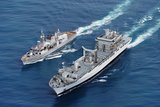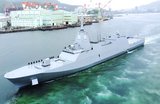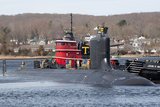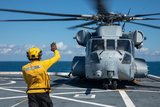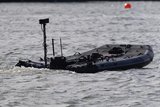HMS Queen Elizabeth completes work package
Babcock International has completed the first docking and maintenance period on the Royal Navy’s HMS Queen Elizabeth at its facility in Rosyth, UK, it was announced on 21 May.
After the planned six-week work package was successfully delivered, the carrier departed Rosyth through the specially designed rollerfender system into the River Forth.
Work under the contract included replacing 284 hull valves and renewing all cathodic protection electrodes and anodes, as well as painting the hull and carrying out work on the stabilisers, rudders and shaft lines.
HMS Queen Elizabeth is due to enter service in 2020 after extensive whole-ship trials.
Related Equipment in Defence Insight
More from Naval Warfare
-
![Hanwha wins Australian government approval to increase its stake in Austal]()
Hanwha wins Australian government approval to increase its stake in Austal
The contract would mean the two shipbuilders can collaborate strategically and enhance shipbuilding capabilities in Western Australia.
-
![Royal Australian Navy sizes up modernisation plans for new and existing capabilities]()
Royal Australian Navy sizes up modernisation plans for new and existing capabilities
The Australian navy is pushing ahead with its efforts to modernise its workforce and capabilities while balancing risky submarine upgrades, ageing Collins-class boats and a shrinking minehunter fleet. Head of navy capability RAdm Stephen Hughes updated Shephard on the force’s progress.
-
![UK to join US Navy’s Virginia-class submarine assembly effort to speed up construction]()
UK to join US Navy’s Virginia-class submarine assembly effort to speed up construction
The expansion of the Virginia-class submarine construction to UK shores could accelerate the project as US shipbuilders continue to fall short of delivery goals.
-
![US Navy seeks new sensors for the CH-53K King Stallion heavy-lift helicopter]()
US Navy seeks new sensors for the CH-53K King Stallion heavy-lift helicopter
The US Navy intends to publish a draft request for proposals in Q2 2026 and conduct an open competition for the supply of new electro-optical and infrared capabilities for the CH-53K heavy-lift helicopter.
-
![What new technologies could be involved in UK Atlantic Bastion initiative?]()
What new technologies could be involved in UK Atlantic Bastion initiative?
As new details emerge on the UK Royal Navy’s plan to secure the North Atlantic for the UK and NATO, three main areas of opportunity for new technology are the focal point.
-
![NATO naval exercises map out future USV requirements but raise questions on acquisition]()
NATO naval exercises map out future USV requirements but raise questions on acquisition
Uncrewed surface vessels have shifted from a desirable capability to a critical one for navies. But should these systems be bought outright, rented as a service or rapidly built using commercial off-the-shelf components?









